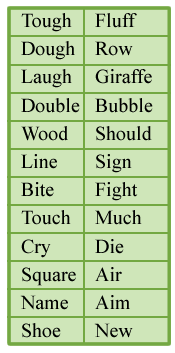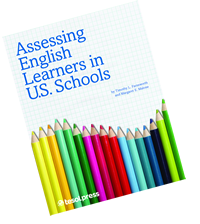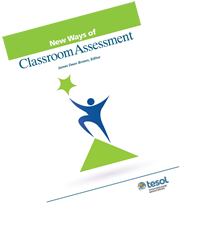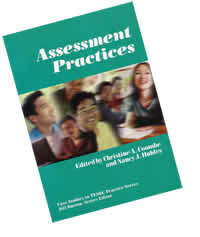Quick Tip: 3 Ideas for Using Rhymes in an English Class
by Elena Shvidko
Audience: Beginning to low-intermediate ESL or EFL students
Using poetry in a language class does not necessarily mean incorporating poems that have a deep philosophical implication or abstract concepts. Even simple rhymed verses can make a difference in your class by fostering learning with more interactive, lively, and enjoyable activities. Here are three ideas to help you get started.
Practicing Pronunciation
To practice pronunciation of English vowels, you can use short rhymed riddles.
Step 1
Prepare several rhymed riddles where the rhyming words would have a target vowel or a diphthong. Here are some examples:
I bring you warmth, I bring you fun.
I am bright and shiny. I am the SUN.
You’ll need a recipe to make
A sweet and yummy chocolate CAKE.
This is a word that rhymes with hat.
I purr and meow, I am a CAT.
This is a word that rhymes with silk.
I am white, I am liquid, I am MILK.
I bring much happiness and joy.
All children like me. I am a TOY.
I am in the dark sky very far.
I am a sparkling little STAR.
Step 2
Display a riddle on a PowerPoint slide (or use a projector, or simply give the students a worksheet) with the final word of the second verse missing:
Examples:
You’ll need a recipe to make
A sweet and yummy chocolate _________.
I bring much happiness and joy.
All children like me. I am a ___________.
Step 3
Ask one student to read the riddle aloud and finish it with the missing word.
Options
If you have more advanced students, you can give each student (or a pair of students) two rhymed words and ask them to create their own riddle for their classmates. Alternatively, you can make it a team competition. Either way, it’s fun, interactive, and creative.
Making Grammar Fun
Grammar exercises don’t need to be dry and boring. You can make a use of rhymes to practice different grammar principles. For example, to have students practice simple past tense, you can give them a few verbs (e.g., to make, to drive, to buy, to watch) and ask them to write simple rhymed verses about what they did the day before/last weekend/last week using past tense forms. Try to include both regular and irregular verbs.
Example (using the verbs to eat, to like, to be):
Last week I ate a cherry cream puff.
I didn’t like it; it was tough.
Options
You can adjust this activity to practice other verb tenses (e.g., present progressive, future).
Fostering Group Work and Interaction
Because writing rhymes is a creative activity, you can use it to enhance student interaction.
Step 1
Prepare a list of rhymed words—about 12–15 pairs. Try to come up with words that rhyme but have different spelling rules.
Examples:

Step 2
Using the words from the first column, prepare cards (with one word written on each card). Write the words from the second column on the board.
Step 3
Ask a student to pick a card, read the word aloud, and find a rhyme for this word from the ones listed on the board.
Step 4
Divide the class into teams and, using the selected word pair, ask each team to create a simple (2-line long) rhymed verse. One person from each team will write the rhyme on the board. The class will decide whose rhyme is the best. You may want to prepare a few simple rubrics for how students should judge verses—or let students come up with their own rubrics prior to the activity.
Step 5
Repeat the activity for the rest of the words you prepared.
Variations
- To make this activity more lively and fun, you can put a time limit on Step 5. There is also much laughter involved in this activity.
- For more advanced students, add more requirements to the verses they come up with: the use of specific tenses, vocabulary words, or themes.
Conclusion
Using rhymed verses does not only allow you to make teaching more fun and interactive, but it also gives students a chance to creatively use their language knowledge. I hope these simple ideas will be helpful to you, and I hope they will lead you in new directions.
___________________
Elena Shvidko is a PhD student in the Department of English at Purdue University. Her academic interests include second language acquisition, second language writing, and writing program administration.
TESOL Blogs
Interested in writing a blog for TESOL?
Contact
Tomiko Breland with your idea or for submission details.
Check out the latest TESOL Blogs:
|
TESOL Convention Blogs
 TESOL bloggers keep you up-to-date and posted on what's happening at the 2014 TESOL convention in Portland, Oregon, live! Read about what sessions they're attending, what the hot topics are this year, and what not to miss next year. Read More. TESOL bloggers keep you up-to-date and posted on what's happening at the 2014 TESOL convention in Portland, Oregon, live! Read about what sessions they're attending, what the hot topics are this year, and what not to miss next year. Read More.
|
|
ESL Games: Synonym Lingo Game, by Marc Anderson
 The Game: Synonym Lingo helps to build reading skills and vocabulary. The Game: Synonym Lingo helps to build reading skills and vocabulary.
Research Says: Using this game with ESL students much like other games for vocabulary presentation and revision, according to Agnieszka Uberman in the article “The Use of Games for Vocabulary. Read More. |
|
6 Ideas for Writing in the Real World, by Elena Shvidko
 Do your students feel uncomfortable writing in the real world? This is a fair concern, and in fact, I can definitely relate to that—when I started to learn English, I was afraid of making mistakes, which oftentimes made me quite anxious. I eventually overcame this fear with the help of my patient teachers and their authentic assignments that allowed me to practice English beyond the classroom. Do your students feel uncomfortable writing in the real world? This is a fair concern, and in fact, I can definitely relate to that—when I started to learn English, I was afraid of making mistakes, which oftentimes made me quite anxious. I eventually overcame this fear with the help of my patient teachers and their authentic assignments that allowed me to practice English beyond the classroom.
There are a whole variety of strategies and activities that could help your students write outside the classroom. I wanted to share some of them...Read More. |
|
Reflections From TESOL’s First Egyptian President: 10 Accomplishments and Lessons Learned, by Deena Boraie
 Time has flown—it seems like it was only yesterday when I was installed as TESOL president in Dallas in March 2013. It has been an amazing year! I was extremely busy; I learned a lot, did a lot, and loved it all. I reviewed what I wrote in the summer of 2011 on my election ballot and here are the three things I promised to do back then: Time has flown—it seems like it was only yesterday when I was installed as TESOL president in Dallas in March 2013. It has been an amazing year! I was extremely busy; I learned a lot, did a lot, and loved it all. I reviewed what I wrote in the summer of 2011 on my election ballot and here are the three things I promised to do back then:
- support the development and implementation of powerful professional learning opportunities for all TESOL members in a variety of contexts
- develop relationships and improve communication with all possible partners and organizations in support of TESOL’s efforts
- bridge research and practice to encourage research in TESOL to focus on the kinds of professional knowledge that teachers need.
Read More. |
TESOL Bookstore

Now It’s Easy to Assess Your English Language Learners
TESOL Press Books Can Help
NEW RELEASE! Assessing English Learners in U.S. Schools
Timothy L. Farnsworth and Margaret E. Malone
 This book views teachers as the people best able to make their students successful. The decisions teachers make about assessments in the areas of literacy, oral language, and content-specific language development result in actionable information. Short reflections, jargon sidebars, and chapter activities make this an enjoyable, user-friendly resource for teachers in any classroom.
This book views teachers as the people best able to make their students successful. The decisions teachers make about assessments in the areas of literacy, oral language, and content-specific language development result in actionable information. Short reflections, jargon sidebars, and chapter activities make this an enjoyable, user-friendly resource for teachers in any classroom.
New Ways of Classroom Assessment, revised
James Dean Brown, Editor
 In this revised edition in the popular New Ways Series, teachers contributed activities whose aim was clearly to help their students. Consequently, more than 100 activities enlighten both students and teachers but are thoroughly integrated into the language teaching and learning processes and do not stand out as different, formal, threatening, or interruptive in the classroom.
In this revised edition in the popular New Ways Series, teachers contributed activities whose aim was clearly to help their students. Consequently, more than 100 activities enlighten both students and teachers but are thoroughly integrated into the language teaching and learning processes and do not stand out as different, formal, threatening, or interruptive in the classroom.
Assessment Practices
Christine Coombe and Nancy Hubley, Editors
 For language educators, teachers, and testers, these studies analyze assessment design, implementation, and review for classrooms, formal tests, programs, curricula, and self-assessment in global scenarios.
For language educators, teachers, and testers, these studies analyze assessment design, implementation, and review for classrooms, formal tests, programs, curricula, and self-assessment in global scenarios.